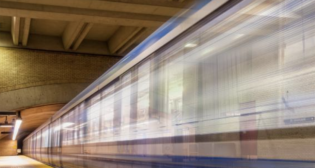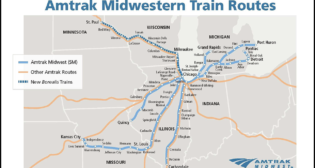
Transit Briefs: NYCT, UTA
Written by Marybeth Luczak, Executive Editor
New York MTA Chair and CEO Janno Lieber, NYCT President Richard Davey and MTA acting Chief Customer Officer Shanifah Rieara recognized Bronx resident Sasha Salazar as the one-billionth subway rider of 2022 on Dec. 27. (Marc A. Hermann / MTA)
MTA New York City Transit’s (NYCT) subway service surpasses one billion riders in 2022. Also, the Utah Transit Authority (UTA) Board of Trustees approves the 2030 Strategic Plan.
New York Metropolitan Transportation Authority (MTA) Chair and CEO Janno Lieber, NYCT President Richard Davey and MTA acting Chief Customer Officer Shanifah Rieara recognized Bronx resident Sasha Salazar as the one-billionth subway rider of 2022 during a ceremony at the 161 Street-Yankee Stadium station on Dec. 27.
The milestone marks the first time the New York City Subway has carried one billion customers in a calendar year since 2019, according to MTA. The subway carried 760 million riders in 2021 and 640 million in 2020. Now, average daily subway ridership is nearly 60% of 2019’s pre-pandemic levels, when the system carried 1.698 billion riders, MTA reported.
Through Oct. 31, the latest date for which comparable all MTA agency non-preliminary data is available, subway ridership is up 38.6% over similar year-to-date data for 2021, New York City Buses are up 13.4%, Metro-North Railroad is up 65.9%, Long Island Rail Road is up 56.9%, Staten Island Railway is up 47.0%, Access-A-Ride is up 11.3%, and traffic on MTA Bridges and Tunnels is up 7.0%, according to MTA.
“In 2022, customers have voted with their MetroCard swipes and OMNY taps, and hundreds of millions have returned to the subway,” Janno Lieber said. “Hitting this milestone, one billion subway riders in 2022, demonstrates again how essential mass transit is to New York City’s economy and continued recovery from the pandemic.”
“Every New Yorker uses the subway every day and I know that we appreciate the MTA, all the workers that work for the MTA especially,” Sasha Salazar said.
UTA’s Board of Trustees on Dec. 21 approved the agency’s 2030 Strategic Plan (see above). The Board, which is required by statute to undergo the strategic planning process every four years, developed the plan with input from agency leadership and community stakeholders, according to UTA. The previous plan was approved in December 2017. UTA provides TRAX (light rail), FrontRunner (commuter rail), S-Line (streetcar), bus, MAX (bus rapid transit), FLEX routes (route-deviated bus), ski bus (offered seasonally), and paratransit bus (for qualified riders only) services.
UTA said the plan includes the following goals to reach by 2030:
- “70% of Utah’s population will reside within one-half mile of UTA transit service.
- “UTA will reduce its carbon footprint from vehicles and facilities by 25%.
- “UTA’s Net Promoter Score (recommending UTA to friends and family) will increase by 45%, gaining 10% every two years.
- “UTA will collaborate with 100 actively engaged alliances who tell their stories in ways that influence transit-friendly outcomes.
- “Positive economic value and returns generated by UTA will be recognized statewide.
- “UTA will receive industry recognition for operating a dynamic and forward-thinking public enterprise.”
“UTA employees are the key to this strategy’s success,” UTA Executive Director Jay Fox said. “Every member of our OneUTA family will own a shared work plan to transform these goals and objectives into reality.”
“This strategic plan raises the standard for UTA” Board Chair Carlton Christensen said. “In collaboration with the community, UTA’s leadership is setting a course for a stronger economy, a cleaner environment, increased mobility, greater access to opportunity and a better quality of life—all driven by safe, reliable transportation.”



